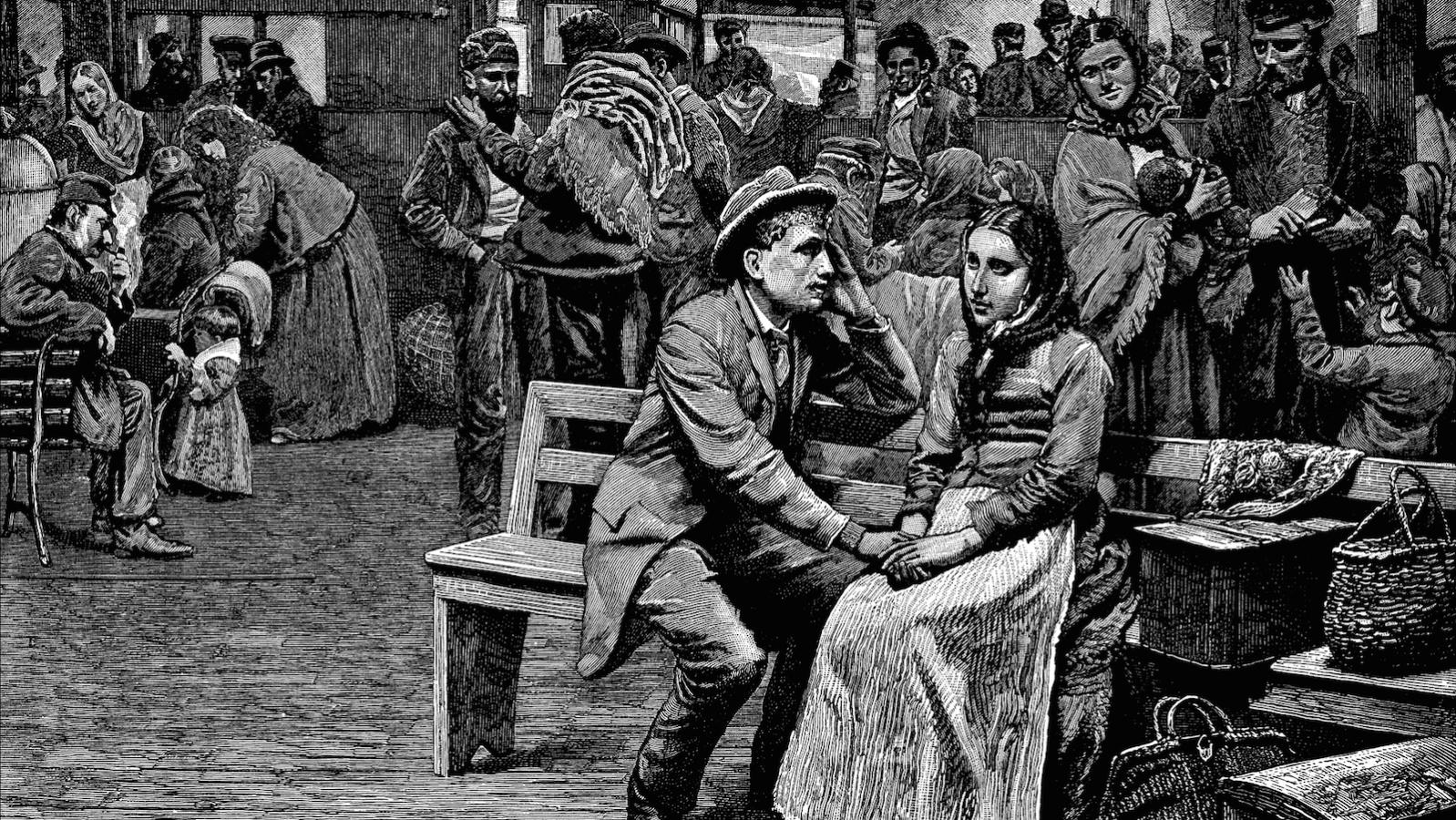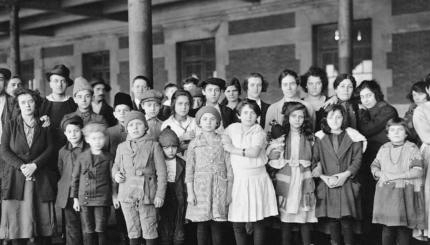Over 3.5 million Jews have immigrated to the United States since the first Jews arrived back in the 17th century. As a result, the vast majority of American Jews are descended from people who came to America from someplace else.
Today, America’s Jewish community is largely Ashkenazi, Jews who trace their ancestry to Germany and Eastern Europe. However, the first Jews to arrive in what would become the United States were Sephardi, tracing their ancestry to Spain and Portugal.
Sephardi Jews
The first Sephardi settlers arrived in New Amsterdam in 1654 from Brazil. For several decades after, adventurous Sephardi and Ashkenazi merchants established homes in American colonial ports, including New Amsterdam (later New York), Newport, Philadelphia, Charleston and Savannah. While Ashkenazi Jews outnumbered Sephardi ones by 1730, the character of the American Jewish community remained Sephardi into the early 19th century.
All of the early Jewish communities were Sephardi-style “synagogue-communities”: the community and the synagogue were one and the same. Even if some leaders were Ashkenazi, they followed the Western Sephardi liturgy and adhered to Sephardi customs. Early American synagogues also seated congregants in the traditional Sephardi manner: women upstairs, men downstairs and everyone seated around the perimeter. They resembled and maintained ties with Western Sephardi congregations elsewhere, such as Amsterdam, London and the West Indies.
Sephardi hegemony ended in the United States in the early decades of the 19th century. Sephardi immigrants nevertheless continued to arrive on America’s shores, initially from Holland and the West Indies, later from the disintegrating Ottoman Empire and still later from Arab lands, the latter now known as Mizrahi (Eastern) Jews. Some 50-60,000 Eastern Sephardi Jews immigrated to the United States between 1880-1924, many of whom spoke Ladino (Judeo-Spanish). More arrived following the 1965 Immigration Act, which ended four decades of quotas and made immigration to the United States easier. Today, an estimated 250,000-300,000 Sephardi Jews of different backgrounds live in the United States, comprising 3-4% of the total U.S. Jewish population.
Central Europeans
Between 1820 and 1880, America’s Jewish population ballooned from 3,000 to 250,000, a rate of growth 15 times greater than that of the U.S. as a whole. An estimated 150,000 Jews emigrated to America during these years, the overwhelming majority young German-speaking Central European Jews from Bavaria, Western Prussia, Posen and Alsace. Like the Catholics and Protestants who emigrated from these lands, Jews were spurred to leave by famine, economic dislocation and political discontent. But Jews emigrated at a rate almost four times that of their non-Jewish neighbors, for they additionally faced severe restrictions on where they could live, what kind of work they could pursue, how they practiced Judaism and even, in some cases, whether they could marry. For them, America represented both economic opportunity and religious freedom.
Overall Jewish emigration from Central Europe peaked in the 1850s — partly in response to the failed liberal revolutions of 1848, partly in response to the antisemitism that followed them, and mostly because of a dramatic rise in food prices and a sharp decline in real wages across the region. While immigration subsequently slackened, German-speaking Jews continued to arrive in America well into the 20th century – 250,000 of them, according to one estimate, by World War I alone.
German-speaking Jews took advantage of America’s expanding frontier and burgeoning market economy. They fanned out across the country, often beginning as peddlers, they spread the fruits of American commerce to the hinterland, building up new markets and chasing after opportunities. They also carried Judaism with them, spreading it literally from coast to coast. By the Civil War, the number of organized Jewish communities with one or more established Jewish institutions reached 160, and individual Jews lived in about 1,000 other American locations, wherever rivers, roads or railroad tracks transported them.
German-speaking Jews transformed American Judaism. The synagogue-communities gave way to communities of (competing) synagogues, most of them Ashkenazi in one form or another and many of them conducted in German. Where Sephardi Jews had venerated ancestral custom and tradition, many German-speaking Jews looked to modernize Judaism in various ways, while a percentage abandoned religion altogether. Some, influenced by liberal religious currents in America and Europe, embraced what came to be known as Reform Judaism, with heightened attention to decorum, vernacular sermons, abbreviated services and a relaxed approach to Jewish laws and customs. Others looked to connect as Jews through fraternal organizations, the best-known being B’nai B’rith. German-speaking Jews also took advantage of new technologies to advance Judaism’s message. Books, periodicals and other publications — in English, Hebrew and German — promoted Jewish education, connected Jews one to another and helped Jews defend themselves.
Eastern Europeans
The unification of Germany in 1871 diminished German-Jewish immigration to the United States, but at that very time East European Jewish immigration to America’s shores began to increase. Violent attacks (known as pogroms) led many to risk life and fortune in the new world, but the root causes of the mass migration lay deeper — in overpopulation, oppressive legislation, economic dislocation, forced conscription, wretched poverty and crushing despair, coupled with tales of wondrous opportunity in America and offers of cut-rate steerage travel. Once again, Jews emigrated at a much higher rate than their non-Jewish counterparts. Between 1880 and the onset of restrictive immigration quotas in 1924, well over two million Jews from Russia, Austria-Hungary and Romania settled in the United States.
The majority of East European Jews spoke Yiddish and found jobs in rapidly growing cities on the East Coast and midwest, especially New York and Chicago, rather than as peddlers on the (fast-shrinking) frontier. Many became involved in the garment industry, as well as in cigar manufacturing, food services and construction. They became active in the labor movement’s struggles to improve conditions for workers; in socialism, communism and Zionism; and in efforts to assist Jews abroad. They also reinvigorated Orthodox Judaism and then the Conservative Movement, which simultaneously promised to be both religiously traditional and modern. By the time mass immigration ended, in 1924, they had reshaped the whole character of the American Jewish community. It now numbered some 3.5 million Jews, mostly of East European descent, and had become the second-largest Jewish community in the world after Eastern Europe.
Yiddish culture — in the form of drama, journalism, poetry, prose and later film — flourished in American Jewish immigrant neighborhoods. Some of the cultural works they produced, since they were not subject to censorship, impacted Europe too. Immigrants and their children likewise became involved in music, the arts and scholarship. The most successful among those whose parents spoke Yiddish, like Leonard Bernstein and Barbra Streisand, eventually made major contributions to the broader culture. The legacy of East European Jewry thus continues to shape both the American Jewish community and America as a whole.
Later Immigrants
The immigrant quotas imposed by law in 1924 greatly reduced, but did not completely foreclose, Jewish immigration to the United States. Some Jews still received quota certificates and immigrated. Others crossed over from Canada or Mexico hoping not to get caught. Still others, such as pulpit rabbis, enjoyed quota exemptions under the law. For humanitarian reasons, about 200,000 European Jewish refugees gained entry in the late 1930s and 40s, some just prior to World War II and some soon afterward.
In the decades following the revised 1965 Immigration Act, six other major groups of Jewish immigrants arrived on America’s shores. The largest by far, at least 500,000, were Jews from the former Soviet Union, who left following the collapse of Communism. Another 60,000-80,000 Persian Jews fled Iran following the 1979 Iranian Revolution. Thousands of Jews from Latin America immigrated to the United State in response to revolution, unrest, persecution and economic collapse. Tens of thousands of Jews from Arab lands immigrated (often via Israel) after being driven out by nationalist Arab governments and hostile Islamic neighbors. As many as 12,000 Jews from South Africa moved to the United States during the tumultuous apartheid era and its aftermath. And over 100,000 Israeli Jews live in the United States. Unlike other Jewish immigrants to America’s shores, many Israeli-Americans speak of returning to their homeland at some point in their lives.
The 2020 Pew survey of American Jews reports that about 10 percent of those over 18 were born abroad. Today, as in the past, immigration impacts upon the size and character of the American Jewish community.
Ashkenazi
Pronounced: AHSH-ken-AH-zee, Origin: Hebrew, Jews of Central and Eastern European origin.
Mizrahi
Pronounced: meez-RAH-khee, Origin: Hebrew for Eastern, used to describe Jews of Middle Eastern descent, such as Jews from Iraq and Syria.
Sephardic
Pronounced: seh-FAR-dik, Origin: Hebrew, describing Jews descending from the Jews of Spain.
talmud torah
Pronounced: TALL-mud TORE-uh, Origin: Hebrew, old-fashioned name for Hebrew school.
Yom Kippur
Pronounced: yohm KIPP-er, also yohm kee-PORE, Origin: Hebrew, The Day of Atonement, the holiest day on the Jewish calendar and, with Rosh Hashanah, one of the High Holidays.


